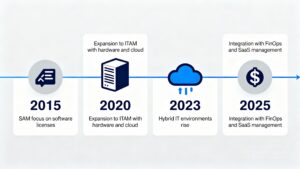Introduction
IT Asset Management (ITAM) has long been considered a best practice for efficient IT operations. But today, it has become a compliance requirement for many organizations. Laws, regulations, and international standards increasingly demand that companies maintain a clear, accurate inventory of their hardware, software, and cloud services.
However, ITAM is not only about avoiding penalties. When done right, it provides strategic benefits: cost optimization, improved cybersecurity, audit readiness, and greater business resilience.
This article explains which organizations are affected by which regulation, what each requires in terms of ITAM, the risks of non-compliance – and the tangible benefits for organizations that embrace ITAM.
1. Copyright & License Agreements (All Companies)
- Who is affected?
Every organization using software, from SMEs to large enterprises. - What’s required?
Copyright law (e.g., EU UrhG) and license agreements (EULA, volume licenses, SaaS subscriptions) mandate that software must only be used within the purchased rights. - Obligation & risks:
Non-compliance can trigger costly vendor audits, back payments, and legal claims. - Benefits of ITAM:
- Avoid overspending on unused licenses.
- Strengthen negotiation leverage with vendors.
- Be fully audit-ready at any time.
2. Financial & Accounting Regulations (All Organizations with Balance Sheets)
- Who is affected?
All companies reporting under HGB, IFRS, or US-GAAP. - What’s required?
IT assets must be inventoried, valued, and depreciated correctly. In Germany, the GoBD adds requirements for audit-proof documentation. - Obligation & risks:
Missing or incorrect asset records can lead to errors in financial statements, tax disadvantages, and issues with auditors. - Benefits of ITAM:
- Accurate valuation and lifecycle tracking.
- Simplified year-end audits.
- Clear cost transparency across IT investments.
3. Data Protection & Information Security (Data-Processing Organizations)
- Who is affected?
Organizations processing personal data or requiring ISO 27001/BSI certification. - What’s required?
- GDPR/DSGVO: Organizations must know on which systems personal data is processed.
- ISO 27001 / BSI IT-Grundschutz: An asset register is mandatory for risk and security management.
- Obligation & risks:
Violations can lead to severe GDPR fines or loss of certifications. - Benefits of ITAM:
- Visibility into where sensitive data resides.
- Faster and more effective incident response.
- Enhanced trust with customers and regulators.
4. NIS-2 Directive (Critical & Important Entities in the EU)
- Who is affected?
Operators of critical and important infrastructure in energy, healthcare, finance, public administration, digital services, transport, and more. - What’s required?
NIS-2 mandates comprehensive risk management, which starts with a complete inventory of IT and Operational Technology (OT) assets. - Obligation & risks:
From October 2024, compliance is mandatory. Breaches may result in heavy fines and regulatory enforcement. - Benefits of ITAM:
- Foundation for cyber resilience and continuity planning.
- Transparency into IT dependencies and vulnerabilities.
- Stronger patch and vulnerability management.
5. Industry-Specific Regulations (Sector-Dependent)
- SOX (US-listed companies): Requires internal controls supported by a complete asset inventory.
- HIPAA (Healthcare, US): Demands traceability and protection of all systems processing patient data.
- PCI DSS (Payment industry, global): Requires full visibility of systems handling cardholder data.
- KRITIS Ordinance (Germany): Obligates operators of critical infrastructure to maintain transparency and security.
- Obligation & risks:
Non-compliance can lead to fines, license withdrawal, or even suspension of operations. - Benefits of ITAM:
- Simplified compliance reporting.
- Reduced audit costs.
- Competitive advantage through demonstrable IT governance.
6. Sustainability & Environmental Directives (All Hardware-Using Organizations)
- Who is affected?
All organizations deploying IT hardware. - What’s required?
- WEEE Directive (EU): Defines rules for hardware disposal and recycling.
- ESG reporting & EU taxonomy: Increasingly require tracking of IT lifecycle, carbon footprint, and sustainability.
- Obligation & risks:
Non-compliance risks include fines, reputational damage, and missed ESG benchmarks. - Benefits of ITAM:
- Proof of compliant disposal and recycling.
- Support for ESG and CSR reporting.
- Cost savings through lifecycle optimization.
Conclusion: Obligation Meets Opportunity
IT Asset Management is no longer optional – it’s mandated by law, regulations, and industry standards.
But organizations that see ITAM as more than just a compliance checkbox gain much more:
- Risk Reduction: Protection against fines, penalties, and reputational damage.
- Cost Efficiency: Elimination of waste and smarter procurement.
- Transparency: Clear, real-time visibility into IT environments.
- Future-Proofing: A strong foundation for cybersecurity, digital transformation, and sustainability.
In short: ITAM is both a legal necessity and a business enabler.
Call to Action
Do you want to turn IT Asset Management into a driver of efficiency and security?
Let’s talk.
I support organizations in building ITAM practices that ensure compliance and create measurable business value.
Contact me today for a consultation.



